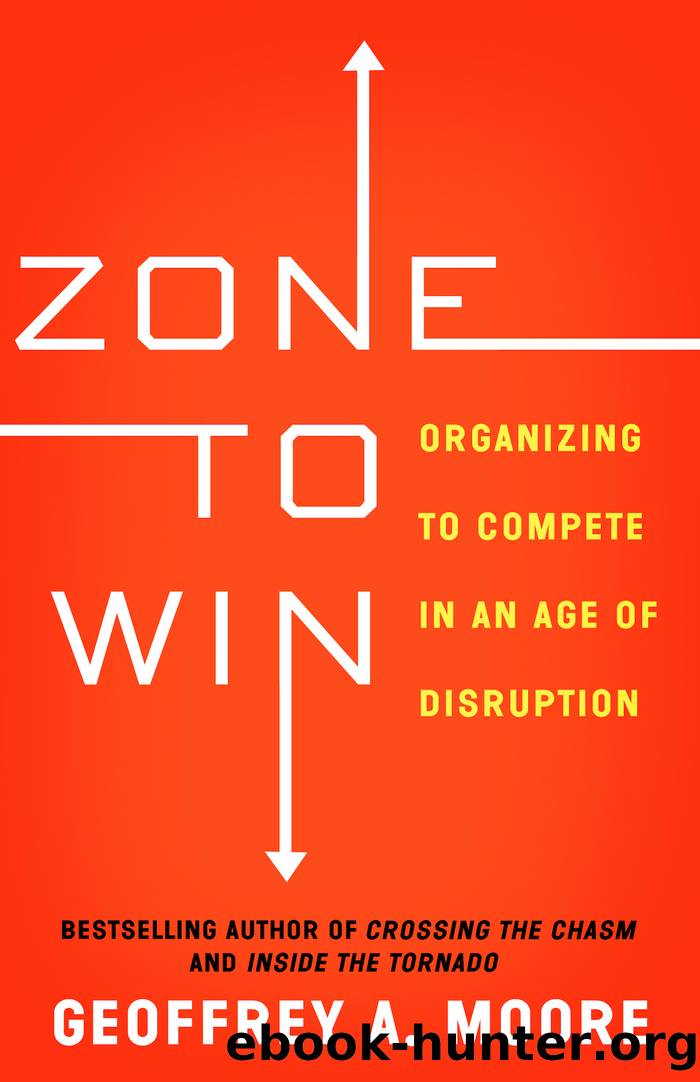Zone to Win by Geoffrey A. Moore

Author:Geoffrey A. Moore [Moore, Geoffrey A.]
Language: eng
Format: epub
Publisher: Diversion Books
Published: 2015-10-20T00:00:00+00:00
The Six Levers
Centralize. Having identified the process to be reengineered and socialized the idea to get support for the effort, your first step is to centralize its governance under a single individual who has both the responsibility and the authority to set new policy and enforce it, end to end. Reengineering is an unpopular act that does not lend itself to democratic decision making. To be sure, at the front end during the design phase you want to engage collaboratively to determine how best to reform the legacy process, but once that effort is under way you need to take a command-and-control approach to see it through the execution phase. Put your commander in place at the beginning, establish executive sponsorship for the person and the role, and then support the heck out of him or her whenever the inevitable rebellion surfaces. Backsliding during a reengineering effort only serves to diminish the rewards while extending the misery.
Standardize. Established enterprises typically grow through multiple mergers and acquisitions, so âstandardâ operating procedures end up varying substantially across equivalent functions. Such variations reduce agility, impede mobility, increase cost of maintenance, and invite errors. Talent gets trapped just compensating for systems that do not talk to each other well. Standardizing to a single instance attacks this kind of waste while establishing a baseline from which all future changes can be launched. It can be a bit draconian, but when disruption strikes, there is no time to pussyfoot around.
Modularize. This is an act of creative imagination in which you decompose the process targeted for reengineering into its functional component elements while ignoring the organizational boundaries that govern its operation currently. Your goal is to reexamine each step in terms of how it changes the state of the workload being processed. Every desired state change deserves its own step, and every step should deliver a desired state change. Note that you are not reengineering yet. You are just putting the value-adding activity more clearly in view while simultaneously identifying as waste those procedures that do not contribute to any desirable state change. Thatâs where the scarce resources you are seeking to liberate are trapped.
Optimize. This is the execution phase, the one where you implement the redesigned process to eliminate waste. Typically it involves merging some tasks, eliminating others, automating repetitive operations, enabling self service where appropriate, leveraging technology solutions where available, predicting and preempting bottlenecks and breakdowns, and providing an SOS button to push whenever something doesnât work. Occasionally it may involve completely revamping the process to leverage a next-generation system that addresses the task in a completely different way. The critical goal here is not to save money nor to be more efficient, although both are likely to occur. Rather, it is to make yourself more effective by freeing up resources you need to repurpose for core. If you do not accomplish this goal, you will have wasted your time.
Instrument. There is a law of diminishing returns when it comes to optimization. At some point
Download
This site does not store any files on its server. We only index and link to content provided by other sites. Please contact the content providers to delete copyright contents if any and email us, we'll remove relevant links or contents immediately.
The ChatGPT Millionaire: Making Money Online has never been this EASY by Neil Dagger(739)
Dan Lok by unknow(657)
Side Hustles for Dummies by Simon Alan R.;(628)
Improving Internet Access to Help Small Business Compete in a Global Economy by Hermann E. Walker(534)
From Science to Business: Preparing Female Scientists and Engineers for Successful Transitions into Entrepreneurship: Summary of a Workshop by Catherine Jay Didion(497)
Start. Scale. Exit. Repeat. by Colin C. Campbell(485)
How to Grow Your Small Business by Donald Miller(483)
Tiny Business, Big Money by Elaine Pofeldt(442)
500 Ways to Make Money by NAVEEN CHAUHAN(441)
Founder vs Investor by Elizabeth Joy Zalman(425)
Do Bigger Things: A Practical Guide to Powerful Innovation in a Changing World by Wilde Jennifer & McClure Dan(404)
Think Your Way to Success: How to Develop a Winning Mindset and Achieve Amazing Results by Mark Rhodes(389)
The Startup Owner's Manual by Steve Blank(384)
The Worth of Water by Gary White & Matt Damon(372)
The Harder I Fall, the Higher I Bounce: Life Lessons From the Entrepreneur Dubbed the King of Kiosks by Fortune Magazine by Max James(371)
Read Books All Day and Get Paid For It: The Business of Book Coaching by Jennie Nash(371)
Studies on hydrolysisalcoholysisammonolysis mechanisms of ethylene terephthalate dimer using DFT method by unknow(369)
SURVIVAL SKILLS FOR FREELANCERS by Townsend Sarah(368)
The Five Most Important Questions You Will Ever Ask About Your Organization by Peter F. Drucker & NULL(367)
